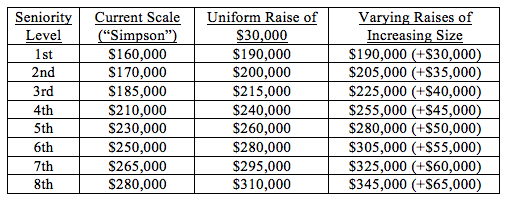NY To $190K: What Should The New Biglaw Pay Scale Look Like?
What should the new starting salary be, and how should pay rise with seniority?
 It seems there’s some pessimism over when we’ll see that next Biglaw pay raise. In a recent reader poll, 36 percent of you predicted that it wouldn’t come until July 2017 or later, and another 25 percent voted “never.”
It seems there’s some pessimism over when we’ll see that next Biglaw pay raise. In a recent reader poll, 36 percent of you predicted that it wouldn’t come until July 2017 or later, and another 25 percent voted “never.”
I think that’s too gloomy. Perhaps Biglaw associates are trying to manage their own expectations or not get their hopes too high, but I think the next salary hike will come much sooner. I stand by my prediction of the first quarter of 2017, but it could come even earlier. It’s certainly the case that associates want it to come earlier (and there will be a major morale boost when it does).
When the new law firm pay scale makes its debut, what will it look like? Here are two issues to consider:

Early Adopters Of Legal AI Gaining Competitive Edge In Marketplace
1. What will be the new starting salary? We’ve been using NY to 190, taken from the old ATL comments meme, as a convenient shorthand. But as we’ve stated before, we could easily see NY to 180 or NY to 200 (which happens to be the starting salary at Williams & Connolly, the D.C. litigation powerhouse that competes with New York’s Biglaw behemoths for top talent; but note that W&C doesn’t pay bonuses).
If the starting salary goes from $160K to $180K, that would represent a 12.5 percent increase. Interestingly enough, that would basically reflect the rate of inflation between 2007 and 2016. According to the Department of Labor’s inflation calculator, the inflation-adjusted equivalent of $160,000 in 2007 is $184,631 in 2016.
Going from $160K to $190K would represent an increase of 18.75 percent. That might seem sizable, but if you spread that growth out over almost a decade, you’re not talking that much more than inflation. And that’s nationwide inflation; the cost of living has increased at a much more rapid pace in New York, San Francisco, and other major cities (which would be the argument in favor of going to $200K, a nice round 25 percent increase).
Could we see a small raise, say, $160K to $170K? It’s possible, although I think it unlikely. A $10,000 raise just seems like a waste of everyone’s time. Recall that the last raise, from $145K to $160K, was $15,000. To raise by $10,000 on a larger base makes for an even smaller raise in percentage terms.
Sponsored

Legal AI: 3 Steps Law Firms Should Take Now

Early Adopters Of Legal AI Gaining Competitive Edge In Marketplace

Is The Future Of Law Distributed? Lessons From The Tech Adoption Curve

Navigating Financial Success by Avoiding Common Pitfalls and Maximizing Firm Performance
Readers, what do you think?
What will be the new Biglaw starting salary?
2. How will salaries increase with seniority? When I’ve had conversations with folks about a possible Biglaw pay hike, I’ve gotten the most pushback on a raise for first- and second-year associates. If junior associates aren’t very knowledgeable or efficient (or profitable), why should they see their salaries go up? Especially when there are thousands of law school graduates who would kill for Biglaw jobs?
(Note: I don’t completely buy that second point. The market for entry-level talent in the legal profession is somewhat bifurcated, and the top law firms compete eagerly for the top law students from the top law schools. The fact that thousands of graduates of low-ranked law schools would love Biglaw jobs is irrelevant to the hiring calculus at Sullivan & Cromwell or Davis Polk.)
Sponsored

Navigating Financial Success by Avoiding Common Pitfalls and Maximizing Firm Performance

The Business Case For AI At Your Law Firm

At the same time, as any legal recruiter can tell you, good midlevel and senior associates remain in high demand. Yes, the Biglaw model relies on a certain amount of associate attrition — but at some firms, there has been a bit too much attrition. Part of this talent shortage in the midlevel and senior ranks, by the way, is arguably the firms’ own fault — when you fire almost 10,000 junior and midlevel lawyers, as Biglaw did during the recession, don’t expect them to magically be there when you want them as midlevel and senior lawyers.
So what does this mean for the next Biglaw pay scale? Larger jumps as you go higher in seniority, in an effort to retain midlevel and senior associates. In other words, instead of raising everyone’s salaries by a uniform $30,000 over the current Simpson Thacher scale, we could see senior lawyers get larger step increases. Here are two sample scales, one involving fixed bump-ups of $30,000 per class year and one involving bump-ups of increasing size as you go up the seniority tree:

These are just examples. The bumps could be smaller or bigger. The main issue is whether there will be fixed increases or variable increases. Again, tell us your thoughts:
What will the new Biglaw pay scale look like?
We’re standing by for your information and opinions on a Biglaw pay hike. As usual, please text us (646-820-8477) or email us. Please include the phrase “NY to 190” somewhere in your text message or email (perhaps as the subject line) so we can find your responses easily in our inboxes. Thanks.
David Lat is the founder and managing editor of Above the Law and the author of Supreme Ambitions: A Novel. You can connect with David on Twitter (@DavidLat), LinkedIn, and Facebook, and you can reach him by email at dlat@abovethelaw.com.







